Module 11 Unit 1 They touch noses! 课件 +嵌入音频(共30张PPT)
文档属性
| 名称 | Module 11 Unit 1 They touch noses! 课件 +嵌入音频(共30张PPT) | 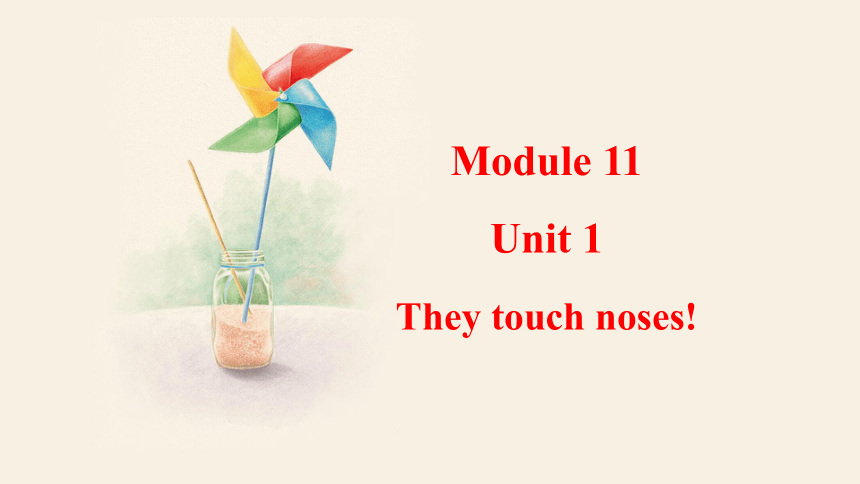 | |
| 格式 | pptx | ||
| 文件大小 | 5.4MB | ||
| 资源类型 | 教案 | ||
| 版本资源 | 外研版 | ||
| 科目 | 英语 | ||
| 更新时间 | 2023-12-30 16:10:12 | ||
图片预览

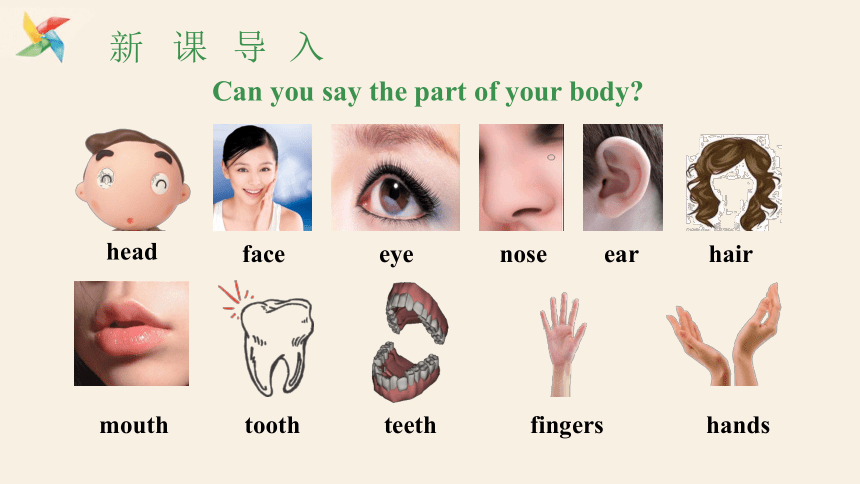

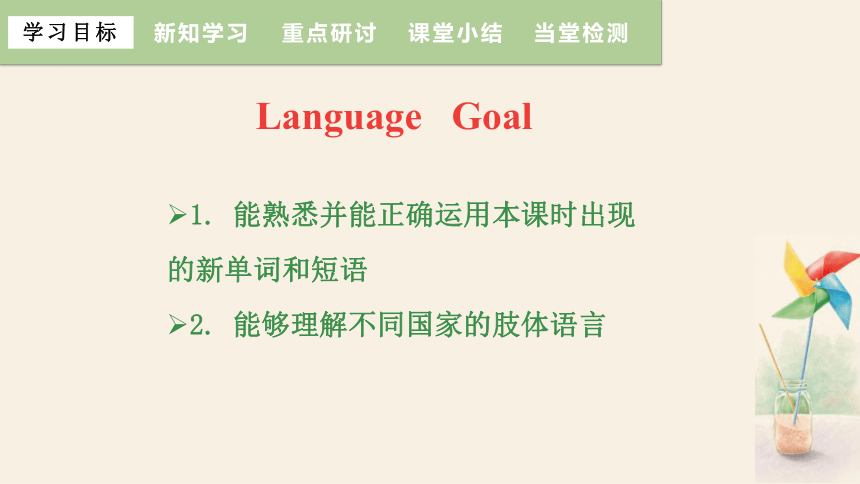
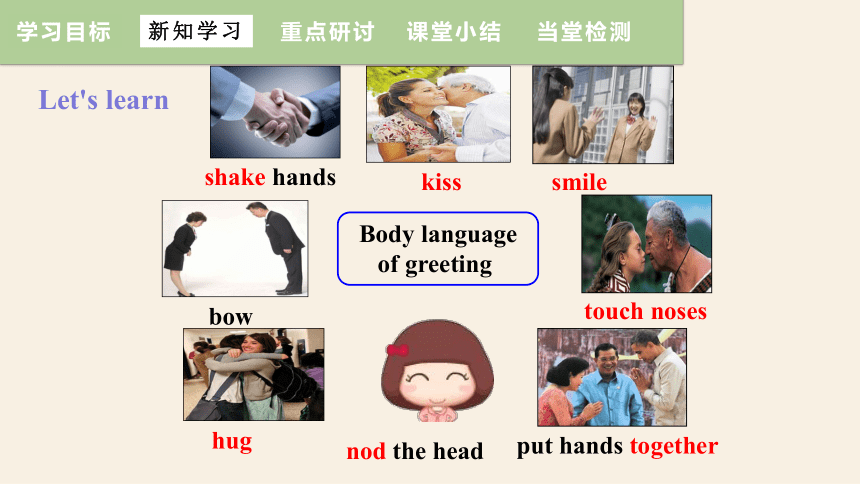
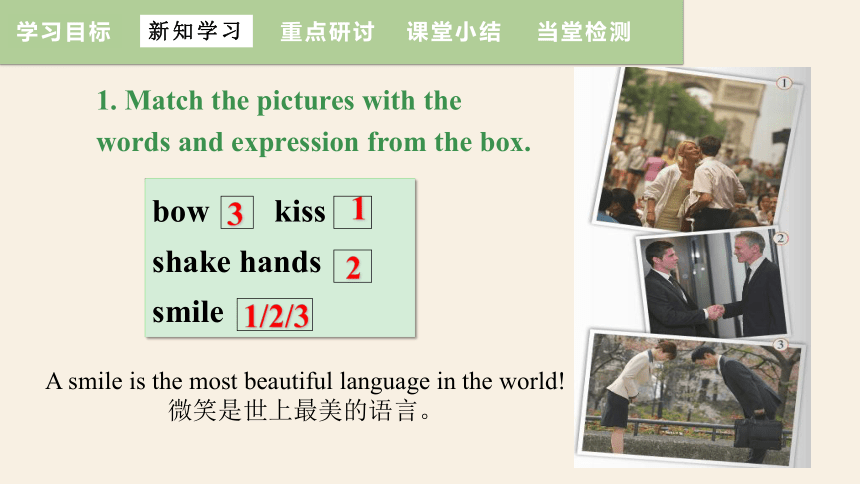
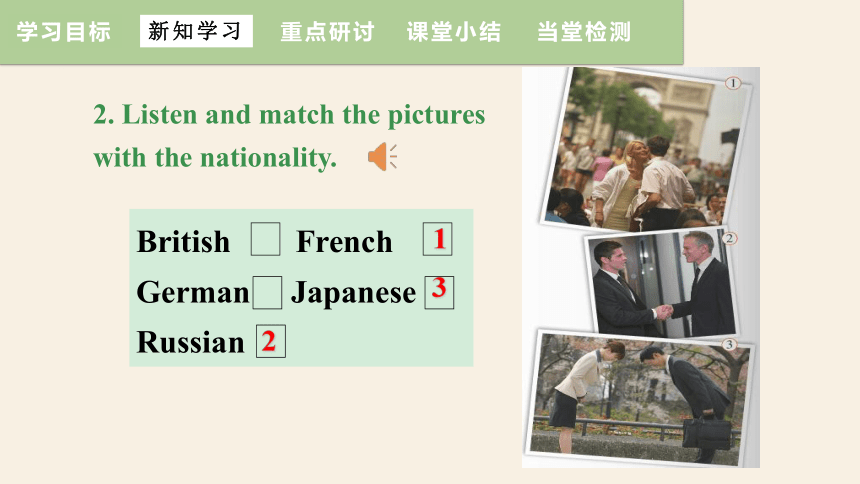
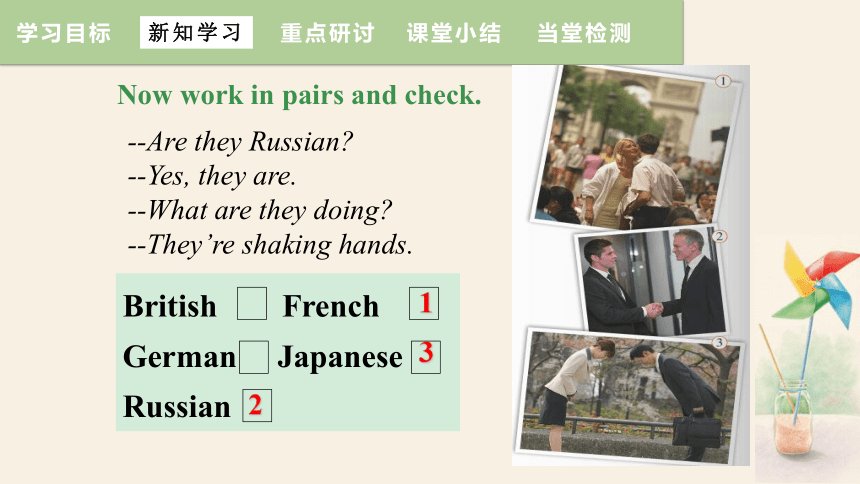
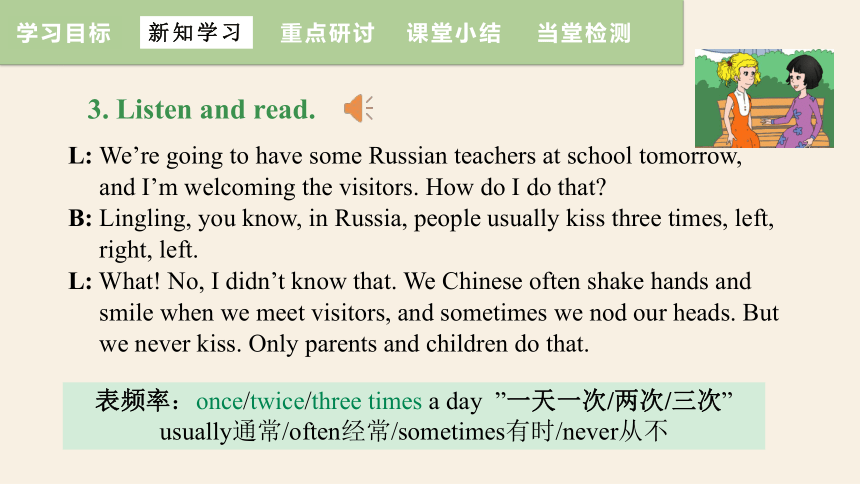
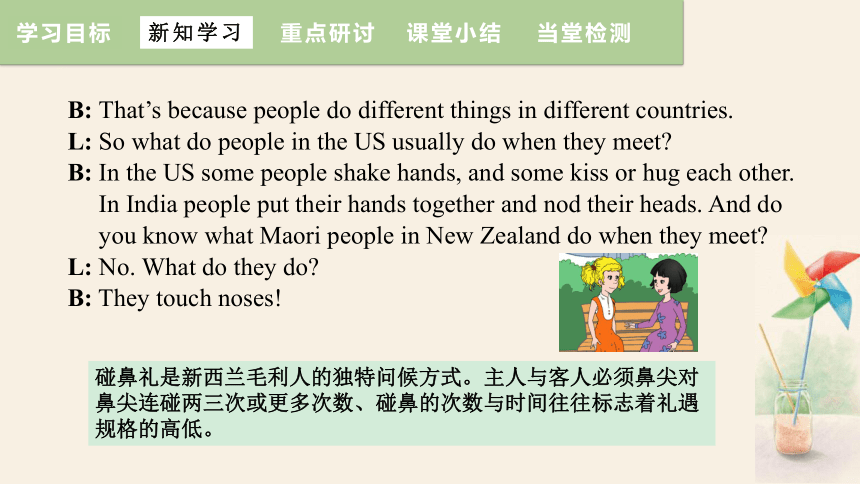
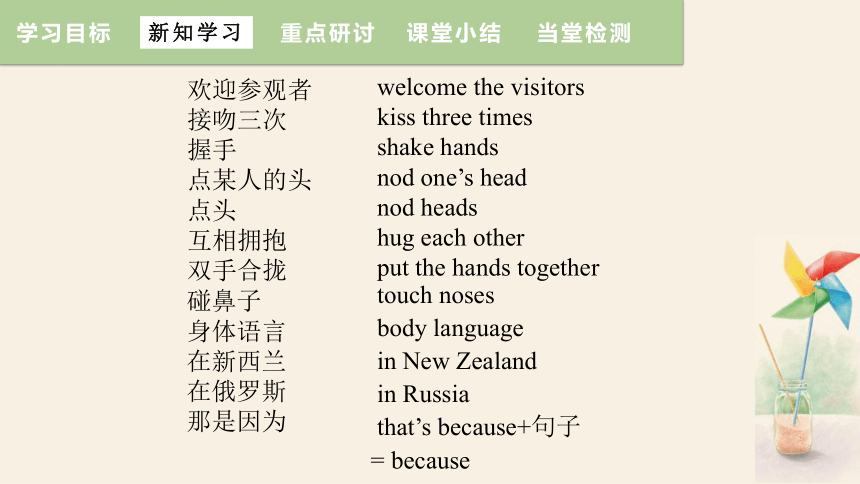
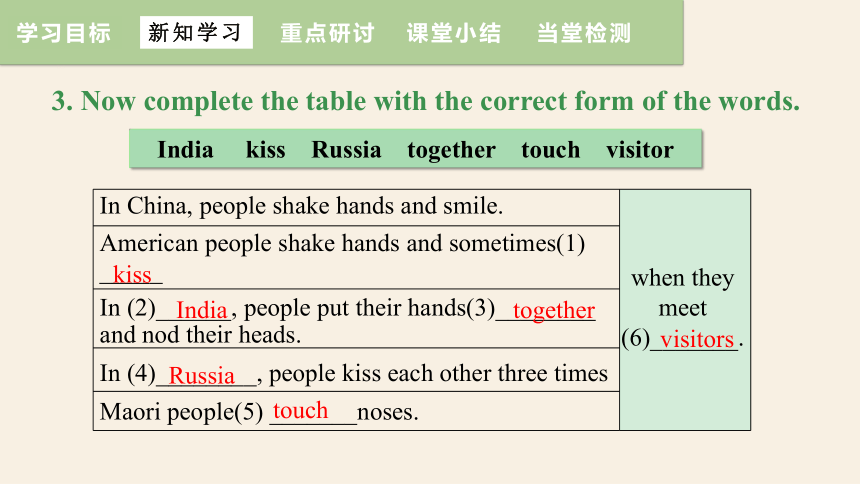
文档简介
(共30张PPT)
Module 11
Unit 1
They touch noses!
新
课
导
入
Can you say the part of your body
head
face
eye
nose
hair
mouth
tooth
teeth
fingers
hands
ear
Do you know some body languages
肢体语言
Stop!
Come here.
Great!
It’s OK.
Bye!
Language Goal
新知学习
课堂小结
当堂检测
学习目标
重点研讨
1. 能熟悉并能正确运用本课时出现的新单词和短语
2. 能够理解不同国家的肢体语言
Body language
of greeting
shake hands
touch noses
smile
kiss
put hands together
hug
bow
nod the head
Let's learn
新知学习
课堂小结
当堂检测
学习目标
重点研讨
新知学习
课堂小结
当堂检测
学习目标
重点研讨
bow kiss shake hands smile
1. Match the pictures with the words and expression from the box.
3
2
1
1/2/3
A smile is the most beautiful language in the world!
微笑是世上最美的语言。
新知学习
课堂小结
当堂检测
学习目标
重点研讨
British French German Japanese Russian
2. Listen and match the pictures with the nationality.
3
2
1
新知学习
课堂小结
当堂检测
学习目标
重点研讨
--Are they Russian
--Yes, they are.
--What are they doing
--They’re shaking hands.
Now work in pairs and check.
British French German Japanese Russian
3
2
1
新知学习
课堂小结
当堂检测
学习目标
重点研讨
3. Listen and read.
L: We’re going to have some Russian teachers at school tomorrow,
and I’m welcoming the visitors. How do I do that
B: Lingling, you know, in Russia, people usually kiss three times, left,
right, left.
L: What! No, I didn’t know that. We Chinese often shake hands and
smile when we meet visitors, and sometimes we nod our heads. But
we never kiss. Only parents and children do that.
表频率:once/twice/three times a day ”一天一次/两次/三次”
usually通常/often经常/sometimes有时/never从不
新知学习
课堂小结
当堂检测
学习目标
重点研讨
B: That’s because people do different things in different countries.
L: So what do people in the US usually do when they meet
B: In the US some people shake hands, and some kiss or hug each other.
In India people put their hands together and nod their heads. And do
you know what Maori people in New Zealand do when they meet
L: No. What do they do
B: They touch noses!
碰鼻礼是新西兰毛利人的独特问候方式。主人与客人必须鼻尖对鼻尖连碰两三次或更多次数、碰鼻的次数与时间往往标志着礼遇规格的高低。
welcome the visitors
kiss three times
shake hands
nod one’s head
nod heads
hug each other
put the hands together
欢迎参观者
接吻三次
握手
点某人的头
点头
互相拥抱
双手合拢
touch noses
body language
in New Zealand
in Russia
that’s because+句子
= because
碰鼻子
身体语言
在新西兰
在俄罗斯
那是因为
新知学习
课堂小结
当堂检测
学习目标
重点研讨
新知学习
课堂小结
当堂检测
学习目标
重点研讨
3. Now complete the table with the correct form of the words.
India kiss Russia together touch visitor
In China, people shake hands and smile.
American people shake hands and sometimes(1) _____
In (2)______, people put their hands(3)________ and nod their heads.
In (4)________, people kiss each other three times
Maori people(5) _______noses.
when they
meet
(6)_______.
kiss
India
together
Russia
touch
visitors
新知学习
课堂小结
当堂检测
学习目标
重点研讨
玲玲:明天我们学校会有一些俄罗斯老师来访,我要去迎接他们,我该怎么做呢?
贝蒂:玲玲,你知道吗,在俄罗斯,人们通常亲吻面颊三次:左、右、左。
玲玲:什么!不,我原来可不知道。我们中国人见到来访者的时候经常握手、微笑,有时候点头示意,但我们从来不亲吻,只有父母和孩子才亲吻。
贝蒂:那是因为不同国家的人们作法不同。
玲玲:那美国人见面时会怎么做呢?
贝蒂:在美国,有一些人握手,还有一些人亲吻或者相互拥抱。在印度,人们把手合拢并点头行礼。你知道新西兰的毛利人见面时怎么做吗?
玲玲:不知道,他们怎么做?
贝蒂:他们碰鼻子!
新知学习
课堂小结
当堂检测
学习目标
重点研讨
Russia: Kiss each other three times.
Left, right, left.
America: Shake hands, kiss or hug
China:Shake hands and nod heads
Japan: Bow and nod their heads.
Maori people: Touch noses.
India: Put hands together and
nod heads.
Different body languages
新知学习
课堂小结
当堂检测
学习目标
重点研讨
People in different countries may use different body language to express (表达) the same meaning (意思) and feelings (感受). When you speak with people from other countries, try to understand (理解) and respect (尊重) their body language.
Learning to learn
bow
shake hands
hug
kiss
smile
wave the hand
body languages to show politeness.
Touch noses
新知学习
课堂小结
当堂检测
学习目标
重点研讨
4. Listen and repeat.
/t / Chinese each French teacher touch
/ / British shake
/pl/ people
/fr/ French
/br/ British
新知学习
课堂小结
当堂检测
学习目标
重点研讨
5.Work in groups. Talk about what you do and say when you meet:
What do you do and say when you meet your teacher
in the morning
I smile and say good morning.
your teacher
your head teacher
your parents after school
your best friend
your best friend's parents
your favourite film star
a visitor to your school
an American
a Russian
新知学习
课堂小结
当堂检测
学习目标
重点研讨
Language Points
国家 某国家的/国籍或语言 某国人复数
China 中国 Chinese Chinese
Japan 日本 Japanese Japanese
England 英国 English Englishmen
France 法国 French Frenchmen
Canada 加拿大 Canadian Canadians
America 美国 American Americans
Australia 澳大利亚 Australian Australians
Russia 俄国 Russian Russians
India 印度 Indian Indians
Germany 德国 German Germans
新知学习
课堂小结
当堂检测
学习目标
重点研讨
1. … in Russia, people usually kiss three times, left, right, left.
……在俄罗斯,人们通常亲吻三次,左、右、左。
kiss v. 吻,亲吻
The mother kissed the sleeping baby .
kiss n. 吻
The boy gave the girl a kiss and went away.
kiss 作名词是______的。如 give a kiss
可数
它的复数形式为__________.
kisses
新知学习
课堂小结
当堂检测
学习目标
重点研讨
“times” 在这里是可数名词,表示次数, three times 表示 “三次”
在英文中,一次, once 两次, twice 三次以上都用“times”
Eg. My mother goes shopping once a week.
我妈妈每周购物一次。
How often does your mother go shopping
拓展:time 不可数名词表示时间,时刻
Eg. What time is it 几点了?
新知学习
课堂小结
当堂检测
学习目标
重点研讨
2. We Chinese often shake hands and smile when we meet visitors,and
sometimes we nod our heads. 我们中国人见到来访者的时候经常
握手并微笑,有时会点头示意。
(1) shake hands的意思是“握手”,
shake hands with sb.表示“与某人握手”。
When I met my boss yesterday, I shook hands with him.
(2) smile n.&v.微笑
smile at sb.对某人笑。
She always smiles at everyone.
新知学习
课堂小结
当堂检测
学习目标
重点研讨
some times的意思是“几次”,表示频率。如:
I forgot to take my umbrella some times.我好几次都忘记带伞。
sometime是副词,意思是“某个时候”(可指过去或将来的某个时候)。
We'll go on a trip sometime in August.
我们会在八月找个时间去度假。(将来)
I bought the hat sometime last summer.
这顶帽子是我上个夏天的某个时间买的。(过去)
辨析:sometimes, some times, sometime及some time
sometimes的意思是“有时候”,是副词。如:
I sometimes receive letters from him.有时候我会收到他的来信。
新知学习
课堂小结
当堂检测
学习目标
重点研讨
some time 的意思是“某段时间”,常与for连用。
We plan to stay in Hong Kong for some time.
我们打算在香港待一段时间。
用sometimes, some times, sometime, some time填空。
①I went to Beijing _________ last year.
②Sometimes he comes by bike and _________ by bus.
③I'll be away for _________.
④I have been to the Great Wall _________.
sometime
sometimes
some time
some times
新知学习
课堂小结
当堂检测
学习目标
重点研讨
3. That's because people do different things in different countries.
那是因为不同国家的人们做法不同。
that's because +句子。这是一个常用句式,表示 “那是因为……”
That's because you were not careful . 那是因为你不够仔细。
我们没有去野餐。那是因为天气很糟糕。
We didn't go for a picnic . _________________________________
That's because the weather is bad
新知学习
课堂小结
当堂检测
学习目标
重点研讨
that's because与that's why的区别
that's because 意为“那是因为……”, 后接表示原因的句子。That's because I didn't know about it.
那是因为我不知道此事。
that's why 意为“那是为什么……”, 后接表示结果的句子。That's why he came late.
那就是他来晚了的理由。
新知学习
课堂小结
当堂检测
学习目标
重点研讨
4. In the US some people shake hands,and some kiss or
hug each other.
在美国,有些人握手,有些人亲吻或者互相拥抱。
each other的意思是“互相”,
We should help each other. 我们应该互相帮助。
新知学习
重点研讨
课堂小结
当堂检测
学习目标
Module 11
Unit 1
重点单词:bow, kiss, shake, smile, British, German, Japanese, Russian, head, nod, hug, touch, nose, together
重点短语:shake hands, each other, three times, put hands together, nod heads, touch noses
重点句式:That's because people do different things...
In Russian, people usually kiss three times, left, right, left.
We Chinese often shake hands and smile when we meet visitors, and sometimes we nod our heads.
新知学习
课堂小结
当堂检测
学习目标
重点研讨
一、根据首字母及句子意思,填入恰当的词。
1. “Welcome!”, she s_____ hands and smiles.
2. She came and gave her grandpa's a h___.
3. If you agree my ideas, you n___ your head.
4. Maori people in New Zealand t_____ noses when they meet.
5. They b____ to their king every morning.
hakes
ug
od
ouch
ow
新知学习
课堂小结
当堂检测
学习目标
重点研讨
二、根据今天所学内容,完成短文。
In _____, people shake hands and smile when they meet visitors. In ______________, people shake hands and sometimes kiss. In _____, people put their hands together and nod their heads. In ______, people usually kiss three times, In ___________, Maori people touch noses.
China
America/the US
India
Russia
New Zealand
Module 11
Unit 1
They touch noses!
新
课
导
入
Can you say the part of your body
head
face
eye
nose
hair
mouth
tooth
teeth
fingers
hands
ear
Do you know some body languages
肢体语言
Stop!
Come here.
Great!
It’s OK.
Bye!
Language Goal
新知学习
课堂小结
当堂检测
学习目标
重点研讨
1. 能熟悉并能正确运用本课时出现的新单词和短语
2. 能够理解不同国家的肢体语言
Body language
of greeting
shake hands
touch noses
smile
kiss
put hands together
hug
bow
nod the head
Let's learn
新知学习
课堂小结
当堂检测
学习目标
重点研讨
新知学习
课堂小结
当堂检测
学习目标
重点研讨
bow kiss shake hands smile
1. Match the pictures with the words and expression from the box.
3
2
1
1/2/3
A smile is the most beautiful language in the world!
微笑是世上最美的语言。
新知学习
课堂小结
当堂检测
学习目标
重点研讨
British French German Japanese Russian
2. Listen and match the pictures with the nationality.
3
2
1
新知学习
课堂小结
当堂检测
学习目标
重点研讨
--Are they Russian
--Yes, they are.
--What are they doing
--They’re shaking hands.
Now work in pairs and check.
British French German Japanese Russian
3
2
1
新知学习
课堂小结
当堂检测
学习目标
重点研讨
3. Listen and read.
L: We’re going to have some Russian teachers at school tomorrow,
and I’m welcoming the visitors. How do I do that
B: Lingling, you know, in Russia, people usually kiss three times, left,
right, left.
L: What! No, I didn’t know that. We Chinese often shake hands and
smile when we meet visitors, and sometimes we nod our heads. But
we never kiss. Only parents and children do that.
表频率:once/twice/three times a day ”一天一次/两次/三次”
usually通常/often经常/sometimes有时/never从不
新知学习
课堂小结
当堂检测
学习目标
重点研讨
B: That’s because people do different things in different countries.
L: So what do people in the US usually do when they meet
B: In the US some people shake hands, and some kiss or hug each other.
In India people put their hands together and nod their heads. And do
you know what Maori people in New Zealand do when they meet
L: No. What do they do
B: They touch noses!
碰鼻礼是新西兰毛利人的独特问候方式。主人与客人必须鼻尖对鼻尖连碰两三次或更多次数、碰鼻的次数与时间往往标志着礼遇规格的高低。
welcome the visitors
kiss three times
shake hands
nod one’s head
nod heads
hug each other
put the hands together
欢迎参观者
接吻三次
握手
点某人的头
点头
互相拥抱
双手合拢
touch noses
body language
in New Zealand
in Russia
that’s because+句子
= because
碰鼻子
身体语言
在新西兰
在俄罗斯
那是因为
新知学习
课堂小结
当堂检测
学习目标
重点研讨
新知学习
课堂小结
当堂检测
学习目标
重点研讨
3. Now complete the table with the correct form of the words.
India kiss Russia together touch visitor
In China, people shake hands and smile.
American people shake hands and sometimes(1) _____
In (2)______, people put their hands(3)________ and nod their heads.
In (4)________, people kiss each other three times
Maori people(5) _______noses.
when they
meet
(6)_______.
kiss
India
together
Russia
touch
visitors
新知学习
课堂小结
当堂检测
学习目标
重点研讨
玲玲:明天我们学校会有一些俄罗斯老师来访,我要去迎接他们,我该怎么做呢?
贝蒂:玲玲,你知道吗,在俄罗斯,人们通常亲吻面颊三次:左、右、左。
玲玲:什么!不,我原来可不知道。我们中国人见到来访者的时候经常握手、微笑,有时候点头示意,但我们从来不亲吻,只有父母和孩子才亲吻。
贝蒂:那是因为不同国家的人们作法不同。
玲玲:那美国人见面时会怎么做呢?
贝蒂:在美国,有一些人握手,还有一些人亲吻或者相互拥抱。在印度,人们把手合拢并点头行礼。你知道新西兰的毛利人见面时怎么做吗?
玲玲:不知道,他们怎么做?
贝蒂:他们碰鼻子!
新知学习
课堂小结
当堂检测
学习目标
重点研讨
Russia: Kiss each other three times.
Left, right, left.
America: Shake hands, kiss or hug
China:Shake hands and nod heads
Japan: Bow and nod their heads.
Maori people: Touch noses.
India: Put hands together and
nod heads.
Different body languages
新知学习
课堂小结
当堂检测
学习目标
重点研讨
People in different countries may use different body language to express (表达) the same meaning (意思) and feelings (感受). When you speak with people from other countries, try to understand (理解) and respect (尊重) their body language.
Learning to learn
bow
shake hands
hug
kiss
smile
wave the hand
body languages to show politeness.
Touch noses
新知学习
课堂小结
当堂检测
学习目标
重点研讨
4. Listen and repeat.
/t / Chinese each French teacher touch
/ / British shake
/pl/ people
/fr/ French
/br/ British
新知学习
课堂小结
当堂检测
学习目标
重点研讨
5.Work in groups. Talk about what you do and say when you meet:
What do you do and say when you meet your teacher
in the morning
I smile and say good morning.
your teacher
your head teacher
your parents after school
your best friend
your best friend's parents
your favourite film star
a visitor to your school
an American
a Russian
新知学习
课堂小结
当堂检测
学习目标
重点研讨
Language Points
国家 某国家的/国籍或语言 某国人复数
China 中国 Chinese Chinese
Japan 日本 Japanese Japanese
England 英国 English Englishmen
France 法国 French Frenchmen
Canada 加拿大 Canadian Canadians
America 美国 American Americans
Australia 澳大利亚 Australian Australians
Russia 俄国 Russian Russians
India 印度 Indian Indians
Germany 德国 German Germans
新知学习
课堂小结
当堂检测
学习目标
重点研讨
1. … in Russia, people usually kiss three times, left, right, left.
……在俄罗斯,人们通常亲吻三次,左、右、左。
kiss v. 吻,亲吻
The mother kissed the sleeping baby .
kiss n. 吻
The boy gave the girl a kiss and went away.
kiss 作名词是______的。如 give a kiss
可数
它的复数形式为__________.
kisses
新知学习
课堂小结
当堂检测
学习目标
重点研讨
“times” 在这里是可数名词,表示次数, three times 表示 “三次”
在英文中,一次, once 两次, twice 三次以上都用“times”
Eg. My mother goes shopping once a week.
我妈妈每周购物一次。
How often does your mother go shopping
拓展:time 不可数名词表示时间,时刻
Eg. What time is it 几点了?
新知学习
课堂小结
当堂检测
学习目标
重点研讨
2. We Chinese often shake hands and smile when we meet visitors,and
sometimes we nod our heads. 我们中国人见到来访者的时候经常
握手并微笑,有时会点头示意。
(1) shake hands的意思是“握手”,
shake hands with sb.表示“与某人握手”。
When I met my boss yesterday, I shook hands with him.
(2) smile n.&v.微笑
smile at sb.对某人笑。
She always smiles at everyone.
新知学习
课堂小结
当堂检测
学习目标
重点研讨
some times的意思是“几次”,表示频率。如:
I forgot to take my umbrella some times.我好几次都忘记带伞。
sometime是副词,意思是“某个时候”(可指过去或将来的某个时候)。
We'll go on a trip sometime in August.
我们会在八月找个时间去度假。(将来)
I bought the hat sometime last summer.
这顶帽子是我上个夏天的某个时间买的。(过去)
辨析:sometimes, some times, sometime及some time
sometimes的意思是“有时候”,是副词。如:
I sometimes receive letters from him.有时候我会收到他的来信。
新知学习
课堂小结
当堂检测
学习目标
重点研讨
some time 的意思是“某段时间”,常与for连用。
We plan to stay in Hong Kong for some time.
我们打算在香港待一段时间。
用sometimes, some times, sometime, some time填空。
①I went to Beijing _________ last year.
②Sometimes he comes by bike and _________ by bus.
③I'll be away for _________.
④I have been to the Great Wall _________.
sometime
sometimes
some time
some times
新知学习
课堂小结
当堂检测
学习目标
重点研讨
3. That's because people do different things in different countries.
那是因为不同国家的人们做法不同。
that's because +句子。这是一个常用句式,表示 “那是因为……”
That's because you were not careful . 那是因为你不够仔细。
我们没有去野餐。那是因为天气很糟糕。
We didn't go for a picnic . _________________________________
That's because the weather is bad
新知学习
课堂小结
当堂检测
学习目标
重点研讨
that's because与that's why的区别
that's because 意为“那是因为……”, 后接表示原因的句子。That's because I didn't know about it.
那是因为我不知道此事。
that's why 意为“那是为什么……”, 后接表示结果的句子。That's why he came late.
那就是他来晚了的理由。
新知学习
课堂小结
当堂检测
学习目标
重点研讨
4. In the US some people shake hands,and some kiss or
hug each other.
在美国,有些人握手,有些人亲吻或者互相拥抱。
each other的意思是“互相”,
We should help each other. 我们应该互相帮助。
新知学习
重点研讨
课堂小结
当堂检测
学习目标
Module 11
Unit 1
重点单词:bow, kiss, shake, smile, British, German, Japanese, Russian, head, nod, hug, touch, nose, together
重点短语:shake hands, each other, three times, put hands together, nod heads, touch noses
重点句式:That's because people do different things...
In Russian, people usually kiss three times, left, right, left.
We Chinese often shake hands and smile when we meet visitors, and sometimes we nod our heads.
新知学习
课堂小结
当堂检测
学习目标
重点研讨
一、根据首字母及句子意思,填入恰当的词。
1. “Welcome!”, she s_____ hands and smiles.
2. She came and gave her grandpa's a h___.
3. If you agree my ideas, you n___ your head.
4. Maori people in New Zealand t_____ noses when they meet.
5. They b____ to their king every morning.
hakes
ug
od
ouch
ow
新知学习
课堂小结
当堂检测
学习目标
重点研讨
二、根据今天所学内容,完成短文。
In _____, people shake hands and smile when they meet visitors. In ______________, people shake hands and sometimes kiss. In _____, people put their hands together and nod their heads. In ______, people usually kiss three times, In ___________, Maori people touch noses.
China
America/the US
India
Russia
New Zealand
同课章节目录
- Module 1 Lost and found
- Unit 1 Whose bag is this?
- Unit 2 Are they yours?
- Unit 3 Language in use
- Module 2 What can you do ?
- Unit 1 I can play the piano
- Unit 2 I can run really fast
- Unit 3 Language in use
- Module 3 Making plans
- Unit 1 What are you going to do at the weekends?
- Unit 2 We're going to cheer the players.
- Unit 3 Language in use
- Module 4 Life in the future
- Unit 1 Everyone will study at home
- Unit 2 Every family will have a small plane.
- Unit 3 Language in use
- Module 5 Shopping
- Unit 1 What can I do for you?
- Unit 2 You can buy everything on the Internet
- Unit 3 Language in use
- Module 6 Around town
- Unit 1 Could you tell me how to get to the Nationa
- Unit 2 The London Eye is on your right.
- Unit 3 Language in use
- Revision module A
- Module 7 My past life
- Unit 1 I was born in a small village.
- Unit 2 I was born in Quincy.
- Unit 3 Language in use
- Module 8 Story time
- Unit 1 Once upon a time….
- Unit 2 Goldilocks hurried out of the house.
- Unit 3 Language in use
- Module 9 Life history
- Unit 1 He left school and began work at the age of
- Unit 2 He decided to be an actor.
- Unit 3 Language in use
- Module 10 A holiday journey
- Unit 1 What did you do?
- Unit 2 This morning we took a walk.
- Unit 3 Language in use
- Module 11 Body language
- Unit 1 They touch noses!
- Unit 2 Here are some ways to welcome them.
- Unit 3 Language in use
- Module 12 Western music
- Unit 1 It's so beautiful!
- Unit 2 Vienna is the centre of European classical
- Unit 3 Language in use
- Revision module B
